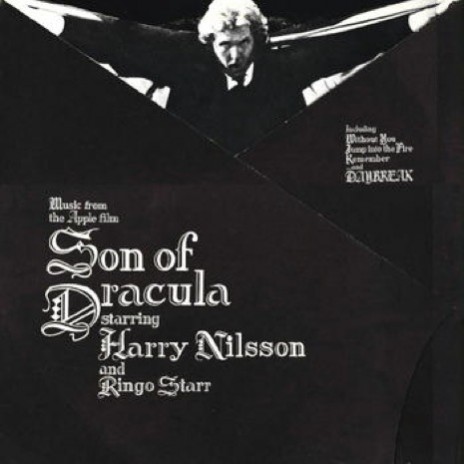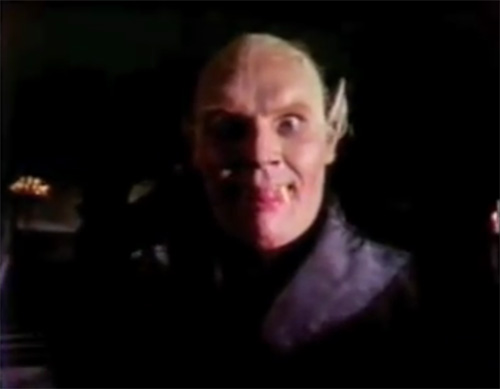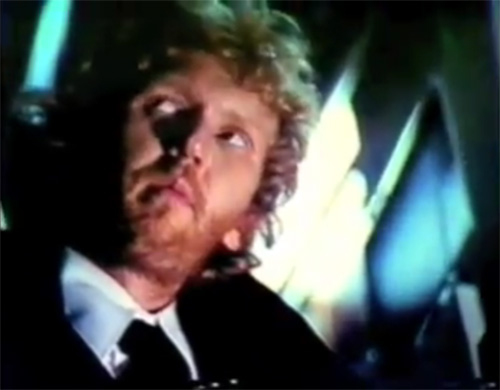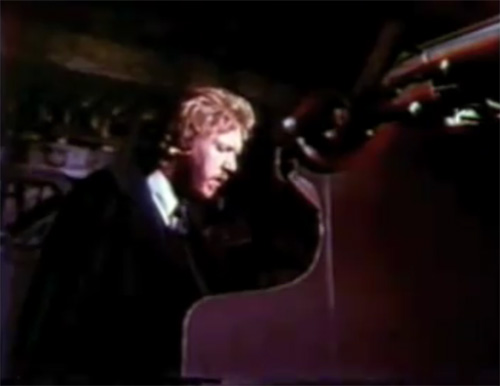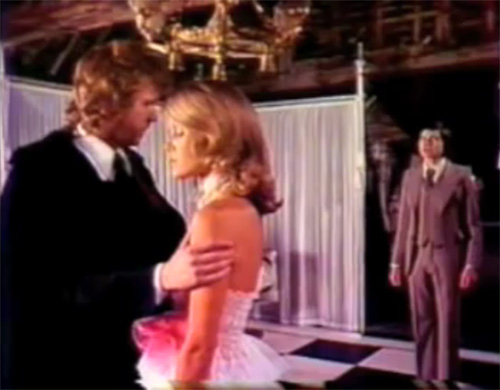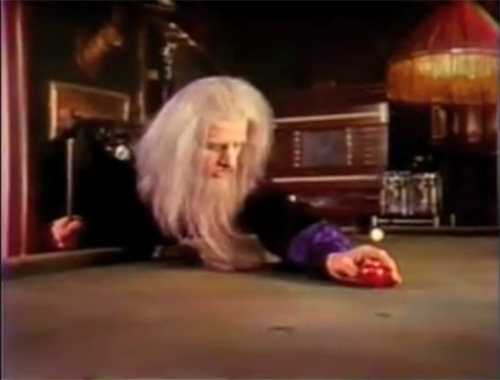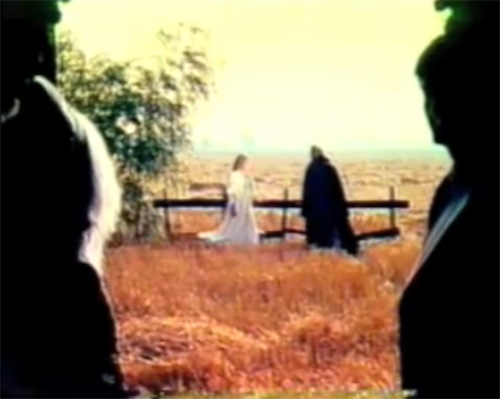No, 1974’s Son of Dracula might not be a good film by any measure, but over the years it may have gotten a worse rap than it deserves. It has a strange pedigree, the kind that a mad scientist might devise, but a pedigree it does have: produced and co-starring Ringo Starr, via the film division of Beatles-founded label Apple, the horror-musical-spoof is directed by noted cinematographer Freddie Francis, and features roles for a pair of reliable British character actors, cameos by members of The Who and Led Zeppelin, and, of course, musical performances and a rare acting job by the great Harry Nilsson.
Francis had, a few years earlier, directed a rather good Dracula film. Stylish, colorful, and reminiscent of either a Grimm’s fairy tale or a child’s nightmare, Dracula Has Risen from the Grave is one of the better films in Hammer’s overstretched Dracula series. (It also featured a clever poster: a woman’s neck and cleavage, with two parallel band-aids over her throat, and the word “Obviously” written beneath the title.) But it cannot be denied that the pre-credits sequence of Son of Dracula offers no hope for anything above the amateurish. The camera takes the POV of a vampire hunter being led forth by a hunchbacked dwarf, who, grinning and chewing the scenery, points the way toward a crypt where Dracula awaits. The long-nailed Dracula looks like Max Schreck’s Nosferatu, but with considerably inferior makeup. The vampire is slain, and the camera irises on the slayer’s hand and his ring, which will helpfully identify who he really is much later in the film.
Then the scene shifts to Merlin (Starr), white-bearded, long-robed, and with a pointy wizard’s hat, stating to his gray and balding servant that Dracula has been killed but his son is still prophesied to be “born in the manner of the human world,” at which point he notices that Dracula’s widow, the Countess–lying asleep in her coffin–is pregnant. He declares that Dracula’s son will one day be declared King of the Netherworld. The underling asks, “When will this be, O master?” and Starr intones seriously, “Not in your lifetime, Brian.”
When the opening credits finally arrive, Nilsson’s voice at least is heard, belting the rocker “Down” over the titles as a hearse drives aimlessly through London. Eventually Nilsson’s character–Count Downe, son of Dracula–climbs out and attacks a young woman and her boyfriend, in a rather stock scene notable only for the presence of the blonde, bearded, serene-faced pop singer as the monster. After this detour, the Count visits “Merlin’s House” (as a subtitle informs us), where Starr awaits, consulting a telescope and his astronomical charts while wearing that wizard’s outfit again, which might be the same one he wears in Magical Mystery Tour. In this brief excerpt, note how the rock stars deliver their deliberately unfunny dialogue completely straight-faced, and you might get a sense of why this film has never received a proper home video release. Who, you might wonder, was this film aimed at?
Count Downe departs Merlin’s House, and visits the streets of London and the lights of Piccadilly Circus. At one point he passes a record shop and sees, displayed in the window, Son of Schmilsson, the cover of which features Nilsson dressed up as Dracula. He gazes at it for a few seconds, his thoughts left disguised to the viewer (contemplating the irony, perhaps?…or just thinking, “That’s a good record, people should buy it”?)…then he turns abruptly and continues walking. A few seconds later, he sees an attractive young woman. He turns, seems about to say something–and continues walking. Right about this time we’re ready for a musical number. Unfortunately, we still have a few more minutes to go.
In a graveyard, Count Downe briefly stops to follow a woman delivering flowers to a grave. She’s suddenly attacked by a werewolf. The Count lunges out of the shadows and draws a sword. He stabs the werewolf, which whimpers and flees. Then the Count seduces and bites the woman in trademarked Christopher Lee fashion. In theory, this is diverting.
At the Merlin-founded Museum of the Occult, where Count Downe is to have his coronation as King of the Netherworld, he wanders through the darkened hall looking at the giant Tarot cards and a variety of wax figures: Frankenstein’s monster, Medusa, another werewolf. Each of them moves, apparently alive, just as he passes by. Eventually he wanders into a room which contains only a piano; he sits down at it and performs “Remember (Christmas).” All of a sudden, the movie is fantastic. It’s a spellbinding scene, all because Nilsson is a spellbinding performer. That is, as a musician.
But there’s a plot, and even a subplot, and all of this is terribly uninteresting. Baron Frankenstein (Freddie Jones, A Clockwork Orange), who is both a member of the “Netherworld” and an immortal, of course (haven’t you read the Mary Shelley book?), declares that he can make Count Downe an immortal too. Since Count Downe is already a vampire, I’m a bit unclear as to why he’s not already immortal, although I think this has something to do with the fact that he was “born in the manner of the human world.” But the Baron needs the Count to first steal for him a “Radioactive Transfusion Machine,” and they have one of those at the local hospital. Nilsson at first expresses some interest in this plan, but never gets around to it. Ultimately the Baron, frustrated, just goes and steals the device himself. From all I’ve heard, he’s not the only one to have had some difficulty dealing with Harry Nilsson.
Van Helsing (Dennis Price, Twins of Evil) also has plans for the Count: he can make him human, and give him the ability to experience real emotions. This is of greater interest to the Count, because he’s fallen in love with Van Helsing’s daughter, Amber (Suzanna Leigh, Lust for a Vampire). By the way, my wife looked up at the television at this point and asked, “Wait, why is Van Helsing helping out the son of Dracula? And why is Merlin a member of the Netherworld?” Well, it turns out that Amber Van Helsing is also a vampire who longs to be human again, and so…look, this isn’t a movie where you’re supposed to ask those sorts of questions. Or any questions. Because if you’re lucky, Nilsson might sing another number.
Hey, and there he goes, singing “Jump Into the Fire” from Nilsson Schmilsson, and isn’t that Keith Moon rocking out on drums? Suddenly Son of Dracula goes from abysmal to fantastic again. There’s just no middle ground for this movie.
What can’t be overemphasized is that seeing Nilsson perform is a valuable thing, since he abhorred live audiences. He preferred the safety and freedom of the recording studio, and when he was not in the studio, he was out crashing Monty Python’s live shows, and carousing with Micky Dolenz, or Starr, or, most notoriously, John Lennon. Watching this film, you cannot deny what a powerful musical presence Nilsson was. You also lament what this film ought to have been: either a more controlled musical under firmer hands (Brian DePalma, for example), or just a straight concert film, if Nilsson could have been convinced to participate in one. Apparently the monster mash storyline was an idea Starr had brought to Nilsson, but it has the feel of a random lark, or perhaps a promotional film for the Schmilsson albums that somehow got padded to feature length. The fact that this film earned a soundtrack release (on RCA/Apple Records) is genuinely surprising.
The climax arrives when the Count and Amber Van Helsing undergo a transfusion to make themselves human, to the tune of Nilsson’s legendary Badfinger cover “Without You.” The man who killed Count Downe’s father turns out to be Baron Frankenstein (his dwarf assistant was Igor), and he wished to kill Downe as well, in hopes of taking the throne as “Overlord of the Underworld.” Merlin announces, over a game of pool, that he knew this all along, but was waiting for the Baron to reveal his true intentions. He dispatches Frankenstein via a suave Billiards move: a ball rolls in the Baron’s direction, and he vanishes in a puff of red smoke. The Count and Amber Van Helsing walk out into the sunlight, united as two human lovers at last.
Despite its many, many shortcomings, the film is somewhat mesmerizing. A lot of this has to do with the soundtrack, of course (which also features a song by T.Rex, though Marc Bolan, a friend of Starr’s, doesn’t make a cameo). A little of it has to do with the fact that director Francis did, at least, manage to get the scenes shot and the film edited together into a somewhat coherent whole; although I’d love to hear of the challenges in doing so. But perhaps the film’s feeling of unreality is caused by the absolutely bizarre decision to write this “spoof” with a straight dramatic script. For a movie that features vampirism, werewolves, Frankenstein and Igor, “radioactive transfusion” and Merlin the magician, you’d expect there to at least be some humor here and there. Nilsson maintains a grave (sorry) expression throughout, committed to his character’s Gothic angst. And Starr delivers the dialogue through his fake beard as though it’s hugely important that the audience not miss a single nuance of the elaborate plot. According to Starr, they attempted to loop new dialogue with help from Monty Python’s Graham Chapman (Wikipedia adds that Douglas Adams and Bernard McKenna were also enlisted), but the dubbed, presumably more comic version was never used. Starr told Q Magazine: “We had the premiere in Atlanta, the first movie since Gone With the Wind to open there, and we had 12,000 kids screaming, we had bands … but we left town the next day, and so did everyone else. In America, the movie only played in towns that had one cinema, because if it had two, no matter what was on down the road, they’d all go there!”
Kind of a shame. There are far worse films, and for historical value at least, Son of Dracula deserves a proper, restored DVD release. It’s right up Rhino’s alley. (Granted, Blu-Ray might be a tad unnecessary.) Until then, you can find the entire film on YouTube.
